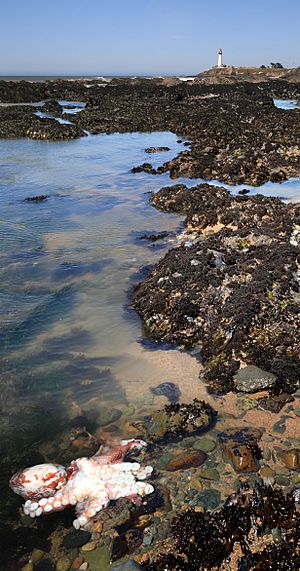Carrier Pigeon (ship) facts for kids
Quick facts for kids History |
|
|---|---|
| Name | Carrier Pigeon |
| Namesake | Carrier pigeon |
| Owner | Reed, Wade & Co., Boston |
| Builder | Hall, Snow & Company, Bath, Maine |
| Launched | 18 October 1852 |
| Fate | Sunk on maiden voyage, 1853 |
| Notes | Wreck sold, with cargo, for US$1,500 (equivalent to $52,800 in 2022) |
| General characteristics | |
| Class and type | Medium clipper |
| Tons burthen | 843 |
| Length | 175 ft 5 in (53.47 m) |
| Beam | 34 ft 5 in (10.49 m) |
| Draft | 21 ft 0 in (6.40 m) |
The Carrier Pigeon was a fast sailing ship called a clipper. It was built in Bath, Maine, and launched in late 1852. This ship was worth about $54,000 at the time. Sadly, on its very first trip, called its maiden voyage, it crashed off the coast of California in 1853.
Contents
The Clipper's First Journey
On January 28, 1853, the Carrier Pigeon set sail from Boston. Its goal was to reach San Francisco, carrying many different goods to sell. The ship and its cargo were protected by insurance, valued at about $195,000.
In the mid-1800s, there was no Panama Canal. This meant ships had to sail all the way around Cape Horn at the southern tip of South America. This area is known for its very strong winds and rough seas. Winds here blow almost constantly from west to east. These strong winds are sometimes called the "Roaring Forties" or "furious fifties" and "screaming sixties" because of how wild they are. Even with these tough conditions, the Carrier Pigeon managed to get around Cape Horn without any problems.
On June 6, 1853, the ship was seen near Santa Cruz, California. San Francisco was only about 70 miles (130 km) north. The California coast often gets thick fog in summer, and this day was no different. As night came, so did the fog. Captain Azariah Doane thought his ship was far from shore. He ordered the ship to sail east, towards the land. Just a few minutes later, the clipper hit hidden rocks.
Huge waves crashed against the ship. Water quickly poured into the ship's hull. About 7 feet (2.1 meters) of cold Pacific water filled the ship. The captain and crew had only moments to escape. Luckily, the ship was only about 500 feet (150 meters) from shore. This meant everyone on board was able to reach the land safely.

Trying to Save the Ship
News of the wreck reached San Francisco by the evening of June 7. The U.S. Coast Survey steamer Active was sent to help. Soon after, another sidewheel steamer named Sea Bird joined the rescue efforts. They hoped to save some of the cargo and anything left of the Carrier Pigeon.
Captain "Bully" Waterman, a famous sailor, led the salvage work on the Sea Bird. The crew of the Carrier Pigeon first focused on getting their own belongings ashore. Captain Waterman, known for his strong personality, quickly got the crew working to save the cargo. He kept things orderly, even when boxes of goods were found. The cargo included many shoes. Locals might have wanted to take some items for themselves, but Captain Waterman stopped this.
The next morning, the Sea Bird found itself in trouble. Strong winds and big waves caused its anchors to drag. The ship started drifting towards the same rocks that had wrecked the Carrier Pigeon. Luckily, Captain John T. Wright, the owner of Sea Bird, knew the area well. He managed to steer his ship to a sandy beach a few miles south, near Año Nuevo. This saved the Sea Bird from being destroyed. It was later pulled back into the water in October.
Another ship, the Goliah, also came to help. It first checked on the Sea Bird before going to the Carrier Pigeon. The Goliah was able to take the Carrier Pigeon's crew and 1,200 packages of its cargo north to San Francisco. On June 10, 1853, a newspaper called The Daily Alta California reported about the Carrier Pigeon:
Its front part lay about 500 feet from the beach. The middle of the ship rested on rocks, which had broken its back. The ocean tide flowed in and out of the ship, reaching up to its lower decks.
Rescue efforts continued for a few more weeks. But by July, the Carrier Pigeon was breaking apart.
Local Stories from the Wreck
These shipwrecks made a big impression on the people living along the San Mateo County coastline. Even with Captain Waterman's efforts, some interesting stories remain about what happened to the cargo from the Carrier Pigeon and Sea Bird.
One story says that people in Pescadero found a lot of white paint from the Carrier Pigeon. They used it to paint all the buildings in their town. Because of this, Pescadero kept the tradition of painting houses white. However, some say the white paint actually came from a different shipwreck in 1896.
Another tale tells of a stagecoach that was saved from the Carrier Pigeon. Workers carefully pulled it up the cliffs to the road. Within a week, it was being used to carry people and goods for the Wells Fargo Company. This stagecoach, built in New Hampshire, was used on the Pescadero road for forty years. In 1914, it was considered one of Wells Fargo's most prized possessions.
Naming of Pigeon Point Lighthouse
A few years later, in 1871, a lighthouse was built on a point of land close to where the Carrier Pigeon crashed. To remember the ship, the lighthouse was named Pigeon Point Lighthouse. This lighthouse is still used today by the United States Coast Guard to help guide ships safely.
Images for kids


